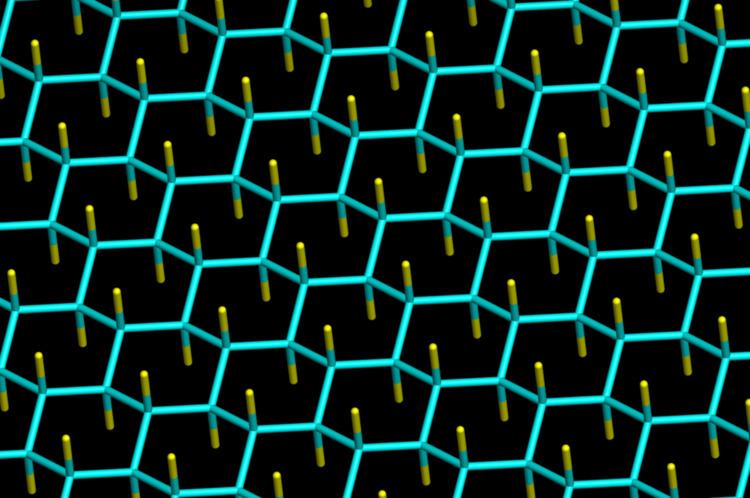 | ||
Fluorographene (or perfluorographane, graphene fluoride) is a fluorocarbon derivative of graphene. It is a two dimensional carbon sheet of sp3 hybridized carbons, with each carbon atom bound to one fluorine. The chemical formula is (CF)n. In comparison, Teflon (polytetrafluoroethylene), -(CF2)n-, consists of carbon "chains" with each carbon bound to two fluorines.
Contents
Unlike fluorographene, graphene is unsaturated (sp2 hybridized) and completely carbon. The hydrocarbon analogue to fluorographene is sp3 hybridized graphane. Similar to other fluorocarbons (e.g. perfluorohexane), fluorographene is highly insulating. Fluorographene is thermally stable, resembling polytetrafluoroethylene; however, chemically it is reactive. It can be transformed back into graphene by reaction with KI under higher temperature. During reactions of fluorographene with NaOH and NaSH simultaneous reductive defluorination and substitution are observed. The reactivity of fluorographene represents a facile way towards graphene derivatives.
Preparation
The material was first described in 2010 by Robinson et al. using graphene grown on copper foil exposed to xenon difluoride at 30 °C. The group of Nair et al. started from cleaved graphene crystals on a gold grid also exposed to xenon difluoride, at 70 °C. Also in 2010 Withers et al. described exfoliation of fluorinated graphite (monolayer, 24% fluorination) and Cheng et al. reported reversible graphene fluorination. The stoichiometric fluorographene (CF) was also prepared by chemical exfoliation of graphite fluoride by Zboril et al. Zboril et al. also showed that the graphene fluoride can be transformed into graphene via graphene iodide, a spontaneously decomposing intermediate.
Structure
Structure of fluorographene can be derived from the structure of graphite monofluoride (CF)n, which consists of weakly bound stacked fluorographene layers, and its most stable conformation (predicted for the monocrystal) contains an infinite array of trans-linked cyclohexane chairs with covalent C–F bonds in an AB stacking sequence. The estimated C-F distance is equal 136-138 pm, C-C 157-158 pm and C-C-C angle 110 deg. Possible fluorographene conformations have been extensivelly investigated computationally.
Electronic properties
Fluorographene is considered a wide gap semiconductor, because its I-V characteristics are strongly nonlinear with a nearly gate-independent resistance greater than 1 GΩ. In addition, fluorescence and NEXAFS measurements indicate band gap higher than 3.8 eV. Theoretical calculations show that estimation of fluorographene band gap is rather challenging task, as GGA functional provides band gap of 3.1 eV, hybrid (HSE06) 4.9 eV, GW 8.1 eV on top of PBE 8.1 or 8.3 eV on top of HSE06. The optical transition calculated by Bethe-Salpeter equation (BSE) is equal to 5.1 eV.
Reaction
Fluorographene is susceptible for nucleophilic substitution and reductive defluorination. Both chemical channels can be used to chemically manipulate with fluorographene. In 2010 it was shown that fluorographene could be transformed to graphene by treatment with KI. Nucleophiles can substitute the fluorine atoms and induce partial or full defluorination. This can be used for synthesis of new graphene derivatives, which contain i) mixture of F and other functional groups (like, e.g., thiofluorographene containing both -F and -SH ) or ii) selectively only the functional group (and any -F groups). In 2017, it was shown that alkyl and aryl groups can be selectively attached to graphene using Grignard reaction with fluorographene and this reaction leads to high-degree of graphene functionalization. Very promising and selective graphene derivative cyanographene (graphene nitrile) was synthethized by reaction of NaCN with fluorographene. This material was used for synthesis of graphene acid, i.e., graphene functionalized by -COOH groups over its surface, and it was shown that this graphene acid can be effectively conjugated with amines and alcohols. These findings open new door for high-yield and selective graphene functionalization.
Other halogenated graphenes
Recent studies have also revealed that, similar to fluorination, full chlorination of graphene can be achieved. The resulting structure is called chlorographene. However other theoretical calculations questioned stability of chlorographene under ambient conditions.
An overview on preparation, reactivity and properties of halogenated graphenes in available in ACS Nano journal free of charge.
